lights Alfa Romeo GT 2007 Owner handbook (in English)
[x] Cancel search | Manufacturer: ALFA ROMEO, Model Year: 2007, Model line: GT, Model: Alfa Romeo GT 2007Pages: 271, PDF Size: 5.57 MB
Page 125 of 271
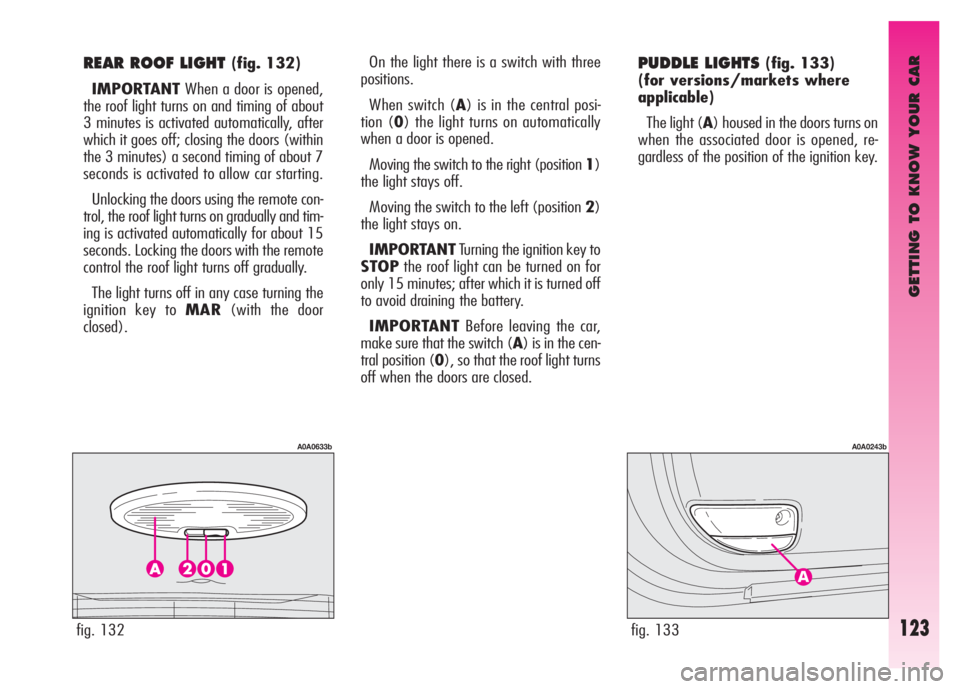
GETTING TO KNOW YOUR CAR
123
REAR ROOF LIGHT (fig. 132)
IMPORTANTWhen a door is opened,
the roof light turns on and timing of about
3 minutes is activated automatically, after
which it goes off; closing the doors (within
the 3 minutes) a second timing of about 7
seconds is activated to allow car starting.
Unlocking the doors using the remote con-
trol, the roof light turns on gradually and tim-
ing is activated automatically for about 15
seconds. Locking the doors with the remote
control the roof light turns off gradually.
The light turns off in any case turning the
ignition key to MAR(with the door
closed).PUDDLE LIGHTS (fig. 133)
(for versions/markets where
applicable)
The light (A) housed in the doors turns on
when the associated door is opened, re-
gardless of the position of the ignition key.
fig. 132
A0A0633b
On the light there is a switch with three
positions.
When switch (A) is in the central posi-
tion (0) the light turns on automatically
when a door is opened.
Moving the switch to the right (position 1)
the light stays off.
Moving the switch to the left (position 2)
the light stays on.
IMPORTANTTurning the ignition key to
STOPthe roof light can be turned on for
only 15 minutes; after which it is turned off
to avoid draining the battery.
IMPORTANTBefore leaving the car,
make sure that the switch (A) is in the cen-
tral position (0), so that the roof light turns
off when the doors are closed.
fig. 133
A0A0243b
Page 128 of 271
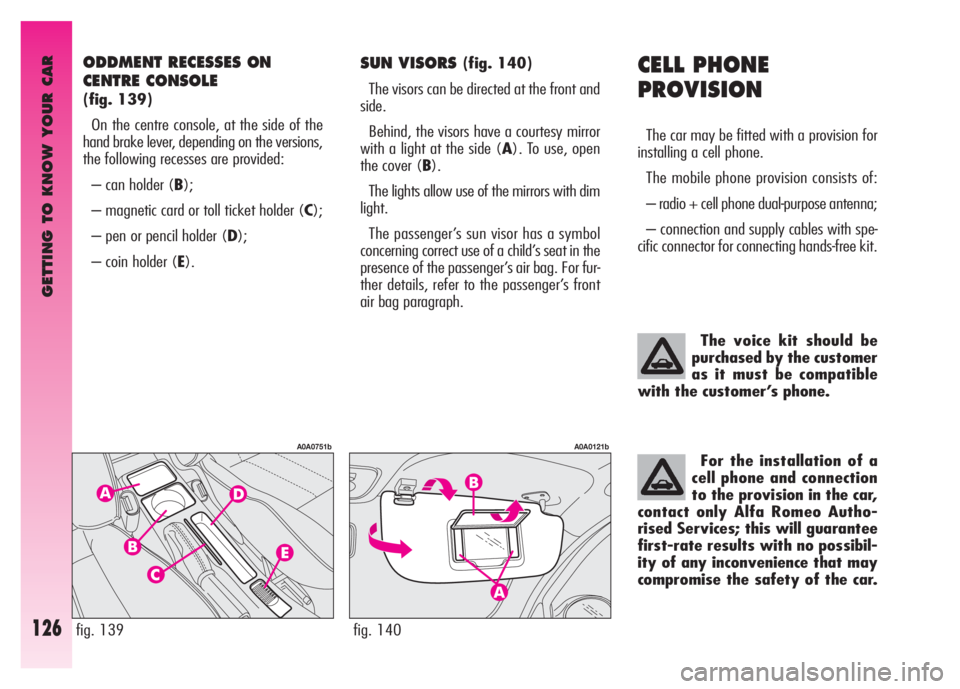
GETTING TO KNOW YOUR CAR
126
CELL PHONE
PROVISION
The car may be fitted with a provision for
installing a cell phone.
The mobile phone provision consists of:
– radio + cell phone dual-purpose antenna;
– connection and supply cables with spe-
cific connector for connecting hands-free kit.
ODDMENT RECESSES ON
CENTRE CONSOLE
(fig. 139)
On the centre console, at the side of the
hand brake lever, depending on the versions,
the following recesses are provided:
– can holder (B);
– magnetic card or toll ticket holder (C);
– pen or pencil holder (D);
– coin holder (E).
SUN VISORS (fig. 140)
The visors can be directed at the front and
side.
Behind, the visors have a courtesy mirror
with a light at the side (A). To use, open
the cover (B).
The lights allow use of the mirrors with dim
light.
The passenger’s sun visor has a symbol
concerning correct use of a child’s seat in the
presence of the passenger’s air bag. For fur-
ther details, refer to the passenger’s front
air bag paragraph.
fig. 139
A0A0751b
fig. 140
A0A0121b
For the installation of a
cell phone and connection
to the provision in the car,
contact only Alfa Romeo Autho-
rised Services; this will guarantee
first-rate results with no possibil-
ity of any inconvenience that may
compromise the safety of the car.
The voice kit should be
purchased by the customer
as it must be compatible
with the customer’s phone.
Page 132 of 271
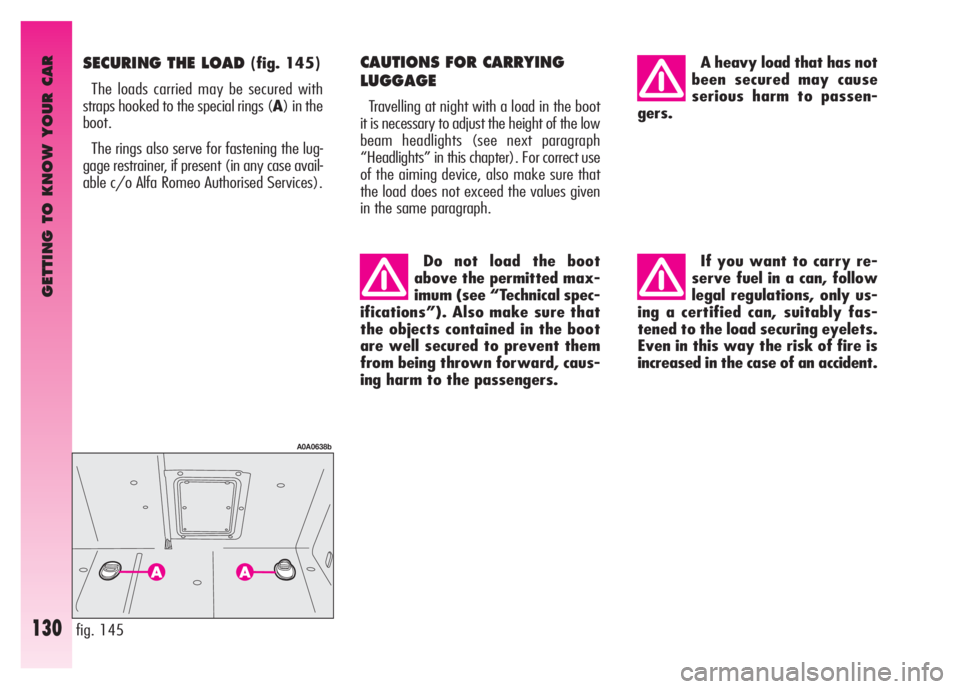
GETTING TO KNOW YOUR CAR
130
Do not load the boot
above the permitted max-
imum (see “Technical spec-
ifications”). Also make sure that
the objects contained in the boot
are well secured to prevent them
from being thrown forward, caus-
ing harm to the passengers.
A heavy load that has not
been secured may cause
serious harm to passen-
gers.
If you want to carry re-
serve fuel in a can, follow
legal regulations, only us-
ing a certified can, suitably fas-
tened to the load securing eyelets.
Even in this way the risk of fire is
increased in the case of an accident.
SECURING THE LOAD (fig. 145)
The loads carried may be secured with
straps hooked to the special rings (A) in the
boot.
The rings also serve for fastening the lug-
gage restrainer, if present (in any case avail-
able c/o Alfa Romeo Authorised Services). CAUTIONS FOR CARRYING
LUGGAGE
Travelling at night with a load in the boot
it is necessary to adjust the height of the low
beam headlights (see next paragraph
“Headlights” in this chapter). For correct use
of the aiming device, also make sure that
the load does not exceed the values given
in the same paragraph.
fig. 145
A0A0638b
Page 134 of 271
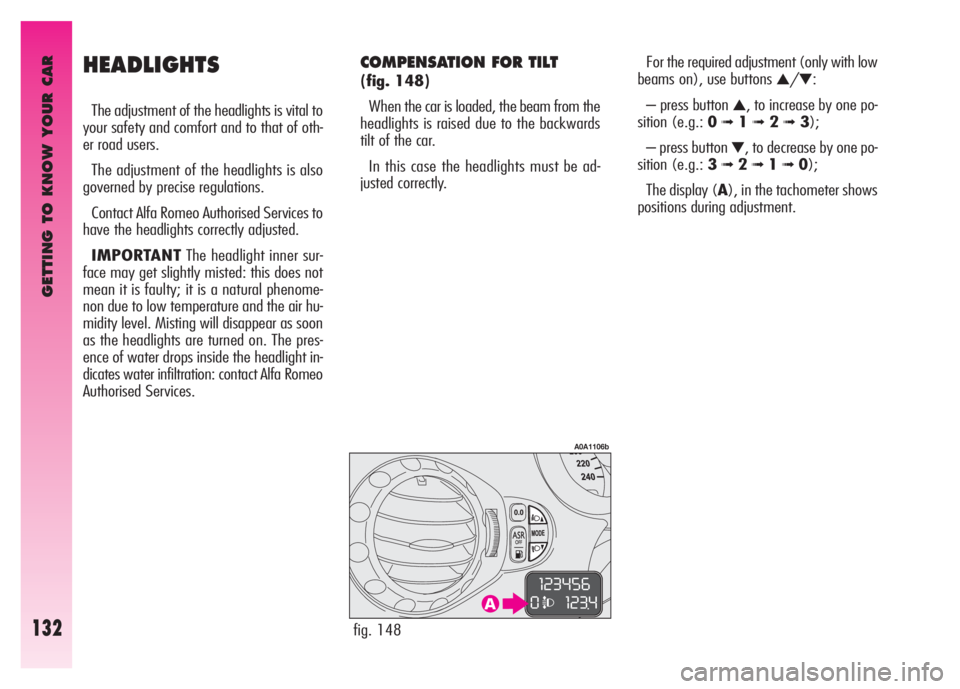
GETTING TO KNOW YOUR CAR
132
HEADLIGHTS
The adjustment of the headlights is vital to
your safety and comfort and to that of oth-
er road users.
The adjustment of the headlights is also
governed by precise regulations.
Contact Alfa Romeo Authorised Services to
have the headlights correctly adjusted.
IMPORTANTThe headlight inner sur-
face may get slightly misted: this does not
mean it is faulty; it is a natural phenome-
non due to low temperature and the air hu-
midity level. Misting will disappear as soon
as the headlights are turned on. The pres-
ence of water drops inside the headlight in-
dicates water infiltration: contact Alfa Romeo
Authorised Services.
COMPENSATION FOR TILT
(fig. 148)
When the car is loaded, the beam from the
headlights is raised due to the backwards
tilt of the car.
In this case the headlights must be ad-
justed correctly. For the required adjustment (only with low
beams on), use buttons ▲/▼:
– press button
▲, to increase by one po-
sition (e.g.: 0
➟1➟ 2➟3);
– press button
▼, to decrease by one po-
sition (e.g.: 3
➟2➟1➟0);
The display (A), in the tachometer shows
positions during adjustment.
fig. 148
A0A1106b
Page 135 of 271
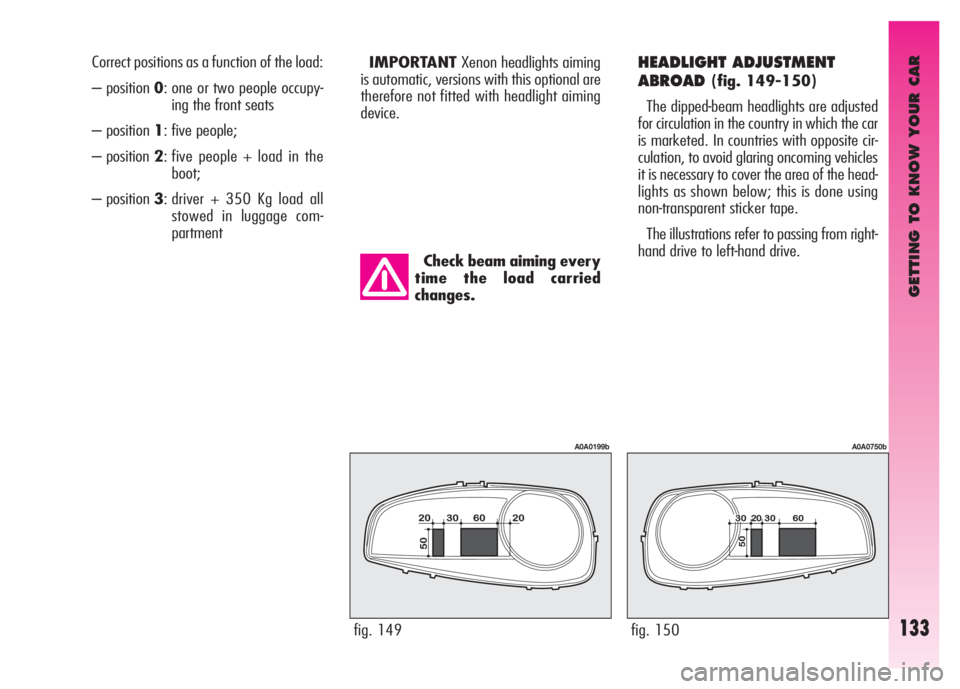
GETTING TO KNOW YOUR CAR
133
Check beam aiming every
time the load carried
changes. Correct positions as a function of the load:
– position 0: one or two people occupy-
ing the front seats
– position 1: five people;
– position 2: five people + load in the
boot;
– position 3: driver + 350 Kg load all
stowed in luggage com-
partment
HEADLIGHT ADJUSTMENT
ABROAD
(fig. 149-150)
The dipped-beam headlights are adjusted
for circulation in the country in which the car
is marketed. In countries with opposite cir-
culation, to avoid glaring oncoming vehicles
it is necessary to cover the area of the head-
lights as shown below; this is done using
non-transparent sticker tape.
The illustrations refer to passing from right-
hand drive to left-hand drive.
IMPORTANTXenon headlights aiming
is automatic, versions with this optional are
therefore not fitted with headlight aiming
device.
fig. 149
A0A0199b
fig. 150
A0A0750b
Page 137 of 271

GETTING TO KNOW YOUR CAR
135
Always take due care when braking on
bends, even with the help of the ABS.
The most important advice of all, howev-
er, is this:
When the ABS cuts in, and
you feel the pulsing on the
pedal, do not lighten the
pressure, but keep the pedal firm-
ly pressed with no fear; this way
you will stop in the least space
possible, compatibly with the con-
ditions of the road surface.
Following these instructions you will be
in the best braking condition under all cir-
cumstances.
IMPORTANTCars fitted with ABS may
only be fitted with the wheel rims, tyres and
brake linings of type and brand approved by
the Manufacturer.
The system is completed by the EBD (Elec-
tronic Brake Distributor) which distributes
the braking action through the control unit
and the ABS system sensors. The car is fitted with an
electronic braking distribu-
tor (EBD). If the
>andx
warning lights turn on simultane-
ously with the engine running, this
indicates an EBD system failure; in
this case with sharp braking the
rear wheels might lock too early,
with the possibility of skidding. Dri-
ving extremely carefully, go to the
nearest Alfa Romeo Authorised Ser-
vice to have the system checked.
The turning on of only the
>warning light with the
engine running normally in-
dicates a fault to the ABS system
only. In this case the braking sys-
tem is still efficient, though with-
out the aid of the anti-lock device.
Under these conditions perfor-
mance of the EBD system may be
reduced. In this case too, you are
advised to go immediately to the
nearest Alfa Romeo Authorised
Service to have the system checked
over, driving in such a way as to
avoid sharp braking.
If the low brake fluid lev-
el
xwarning light turns
on, stop the car immedi-
ately and contact the nearest Alfa
Romeo Authorised Service. Any
loss of fluid from the hydraulic sys-
tem will negatively affect the op-
eration of the braking system be it
of the conventional type or of the
type with ABS.
If the compact spare
wheel is used, operation of
the ABS system is cut off
and the
>warning light on the in-
strument cluster turns on.
IMPORTANTIf the battery is run down
the
>andxwarning lights might turn on
when starting the engine and go off after
starting. This should not be considered as
a fault but as a warning that during start-
ing the ABS is not active. The turning off
of the warning lights ensures normal system
operation.
Page 174 of 271

CORRECT USE OF THE CAR
172
Never leave children un-
attended in the car. Al-
ways remove the ignition
key when leaving the car and take
it with you.To avoid useless con-
sumption of power and
possible draining of the
battery, never leave the ignition
key in the MAR position when the
engine is not running.
PARKING
When the car is parked, proceed as fol-
lows:
– Switch off the engine.
– Engage the handbrake.
– Engage first gear if the car is faced up-
hill or reverse if the car is facing downhill.
– Turn the front wheels so that the car will
immediately come to a halt if the handbrake
slips.
REDUCING
RUNNING COSTS
AND ENVIRONMENT
POLLUTION
By following a few simple guidelines, it
is possible to save car running costs and re-
duce harmful emissions.
GENERAL CONSIDERATIONS
Car maintenance
To take care of the car maintenance have
the checks and adjustments carried out in
accordance with the “Scheduled Mainte-
nance Programme”.
Tyres
Check the pressure of the tyres routinely
at an interval of no more than 4 weeks: if
the pressure is too low consumption levels
increase as resistance to rolling is higher.
Useless loads
Never travel with an overload in the boot.
The weight of the car (especially in urban
traffic), and its geometry heavily affect con-
sumption levels and stability.Electric services
Use electric devices only for the amount of
time needed. Rearscreen heating, addition-
al headlights, windscreen wipers and heater
fan need a considerable amount of energy,
therefore increasing the requirement of cur-
rent increases fuel consumption (up to
+25% in the urban cycle).
Climate control system
The climate control system is a further load
bearing heavily on the engine inducing high-
er consumption levels(up to +20% on av-
erage). Outside temperature permitting,
preferably use the air vents.
Aerodynamic items
The use of non-certified aerodynamic items
may adversely affect air drag and con-
sumption levels.
Page 175 of 271

CORRECT USE OF THE CAR
173
CONDITIONS OF USE
Cold starting
Short journeys and frequent cold starts do
not allow the engine to reach optimum op-
erating temperature. This results in a sig-
nificant increase in consumption levels (from
+15 to +30% on the urban cycle) and emis-
sion of harmful substances.
Traffic situations and road
conditions
Rather high consumption levels are tied to
situations with heavy traffic, for example
in queues with frequent use of the lower
gears or in cities with many traffic lights. Al-
so winding mounting roads and rough road
surfaces adversely affect consumption.
Stopping in the traffic
During prolonged stops (e.g. level cross-
ings) it is advisable to switch the engine off.
DRIVING STYLE
Starting
Do not warm the engine with the car at a
standstill or at idle or high speed: under
these conditions the engine warms up much
more slowly, increasing electrical consump-
tion and emissions. It is therefore advisable
to move off immediately, slowly, avoiding
high speeds. This way the engine will warm
faster.
Pointless manoeuvres
Avoid accelerating when waiting at traffic
lights or before switching off the engine. This
and also double declutching is absolutely
pointless on modern cars and also increase
consumption and pollution.
Gearshifting
As soon as the conditions of the traffic and
road allow, use a higher gear.
Using a low gear to obtain brilliant per-
formance increases consumption.
In the same way improper use of a high
gear increases consumption, emissions and
engine wear.Top speed
Fuel consumption considerably increases
with speed. Maintain an even as possible
speed, avoiding superfluous braking and ac-
celerating, which cost in terms of both fuel
and emissions.
Acceleration
Accelerating heavily taking the engine to
a high speed has a considerably adverse ef-
fect on consumption and emission levels;
it is wise to accelerate gradually and not ex-
ceed the maximum torque.
Page 181 of 271

IN AN EMERGENCY
179
3) Fully depress the accelerator pedal and
keep it pressed. The
Uwarning light will
come on for eight seconds and then go off,
now release the accelerator pedal.
4) The
Uwarning light begins to flash:
after it has flashed the same number of
times as the first digit on the CODE card,
press the accelerator pedal and keep it
pressed until the
Uwarning light turns on
(for four seconds) and then goes off; now
release the accelerator pedal.
5) The
Uwarning light starts to flash: af-
ter the number of flashes corresponding to
the second digit on the CODE card, press the
accelerator pedal and keep it pressed.
6) Repeat this procedure for the remain-
ing digits on the CODE card.
7) After entering the last figure, keep the
accelerator pedal pressed. The
Uwarning
light turns on (for four seconds) and then
goes off; now release the accelerator pedal. 8) A quick flash of the
Uwarning light
(for about four seconds) confirms that the
operation has been carried out correctly.
9) Start the engine turning the ignition key
fromMARtoAV Vwithout returning the
key to the STOPposition.
Conversely, if the
Uwarning light stays
on, turn the key to STOPand repeat the
procedure starting from point 1).
IMPORTANTAfter emergency starting
it is advisable to contact Alfa Romeo Au-
thorised Services, because the emergency
procedure must be repeated each time the
engine is started.
EMERGENCY
STARTING
If it is not possible to deactivate the engine
inhibitor with the Alfa Romeo CODE system,
the
YandUwarning lights stay on and
the engine will not start. Emergency start-
ing is needed to start the engine.
IMPORTANTYou are advised to care-
fully read the entire procedure before carry-
ing it out. If a mistake is made during the
emergency procedure, the ignition key should
be turned to STOPand the operations must
be repeated from the start (point 1).
1) Read the 5-figure electronic code on the
CODE card.
2) Turn the ignition key to MAR.
I I
N N
A A
N N
E E
M M
E E
R R
G G
E E
N N
C C
Y Y
Page 183 of 271

IN AN EMERGENCY
181
STARTING BY INERTIA
If the car is equipped with “Kit for tyre re-
pair Fix&Go“, see the instructions contained
in the following chapter.
GENERAL INSTRUCTIONS
As an alternative to the FIX & GO, the car
can be provided (upon request) with space-
saver spare wheel or standard wheel; wheel
changing and correct use of the jack call for
some precautions as listed below.
IN THE EVENT OF A PUNCTURE
Never push, tow or coast
start the car. This could
cause fuel to flow into the
catalyst damaging it irreversibly.
Remember that the en-
gine brake and power
steering are not opera-
tional until the engine is started,
therefore, much greater effort than
usual is needed on the brake ped-
al and steering wheel.
Signal the presence of the
stationary car according to
current regulations: hazard
warning lights, reflecting triangle
etc.. Any passengers should leave
the car and wait for the wheel to be
changed out of harm of the traffic.
If parked on a slope or rough sur-
face, chock the wheels with
wedges or other suitable devices
to prevent the car from rolling.
Never start the engine
with the car jacked.
When driving with a trail-
er, disconnect the trailer before
raising the car. The compact spare
wheel is specific to your car, do not
use it on other models, or use the
spare wheel of other models on
your car.
Should the type of wheels used
be changed (alloy rims instead of
steel), it is also necessary to
change the whole set of fastening
bolts with others of suitable size.
The compact spare wheel is nar-
rower than normal wheels, it
should be used only for the dis-
tance necessary to reach a service
point to have the punctured tyre
repaired and, during its use, the car
speed must not exceed 80 km/h.